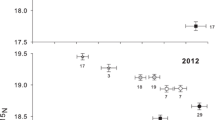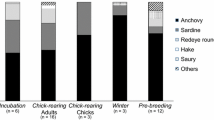Abstract
The availability of food resources has been suggested as a major factor in the substantial increase in reproductive output, survival, recruitment and, ultimately, population growth rates in most organisms. In fact, the artificial increase in food availability resulting from human activities has been suggested as a factor in the substantial increase in population size of several seabirds in recent decades. In the present study, our primary aim was to estimate the importance of the main natural prey and two alternative feeding resources, fishery discards and the invasive American crayfish Procambarus clarkii, for an opportunistic seabird, the Audouin’s gull Larus audouinii. We also assessed the influence of age and sex in the use of those three types of food. For this purpose, we compared the analyses of δ15N and δ13C in blood of male and female adults of known age and chicks with those in their potential prey. Our results reveal sex-related and age-related differences in the consumption of fish discards, small pelagic fish and American crayfish. Differences in the diet of males and females and also between adults and chicks could be related to different nutritional requirements. Age differences were probably related to their different foraging proficiency and the tendency of young breeders to opportunistically exploit anthropogenically derived food. This study illustrates the importance of considering the age and sex of individuals to obtain feasible dietary information and to understand how the exploitation of food of human origin could affect population growth.



Similar content being viewed by others
References
Arcos JM, Oro D (2002a) Significance of fisheries discards for a threatened Mediterranean seabird, the Balearic shearwater Puffinus mauretanicus. Mar Ecol Prog Ser 239:209–220
Arcos JM, Oro D (2002b) Significance of nocturnal purse seine fisheries for seabirds: a case study off the Ebro Delta (NW Mediterranean). Mar Biol 141:277–286
Arcos JM, Oro D, Sol D (2001) Competition between yellow-legged gull Larus cachinnans and Audouin’s gull Larus audouinii associated with commercial fishing vessels: the influence of season and fishing fleet. Mar Biol 139:807–816
Bearhop S, Waldron S, Votier SC, Furness RW (2002) Factors that influence assimilation rates and fractionation of nitrogen and carbon stable isotopes in avian blood and feathers. Physiol Biochem Zool 75:451–458
Blount JD, Surai PF, Nager RG, Houston DC, Moller AP, Trewby ML, Kennedy MW (2001) Carotenoids and egg quality in the lesser black gull Larus fuscus: a supplemental feeding study of maternal effects. P Roy Soc B-Biol Sci 269:29–36
Blount JD, Houston DC, Surai PF, Moller AP (2004) Egg-laying capacity is limited by carotenoid pigment availability in wild gulls Larus fuscus. P Roy Soc B-Biol Sci 271:79–81
Bosch M, Oro D, Ruiz X (1994) Dependence of Yellow-legged Gulls (Larus cachinnans) on food from human activity in two Western Mediterranean colonies. Avocetta 18:135–139
Burger J, Gochfeld M (1996) Family Laridae (Gulls). In: Del Hoyo J, Sargatal J (eds) Handbook of the birds of the world. Lynx Edicions, Barcelona
Cairns DK (1992) Population regulation of seabird colonies. In: Power DM (ed) Current ornithology. Kluwer/Plenum, Dordrecht
Caut S, Angulo E, Courchamp F (2009) Variation in discriminant factors (δ15N and δ13C): the effect of diet isotopic values and applications for diet reconstruction. J Appl Ecol 46:443–453
Coll M, Palomera I, Tudela S, Dowd M (2008) Food-web dynamics in the South Catalan Sea ecosystem (NW Mediterranean) for 1978–2003. Ecol Model 217:95–116
Daunt F, Wanless S, Harris MP, Monaghan P (1999) Experimental evidence that age-specific reproductive success is independent of environmental effects. P Roy Soc B-Biol Sci 266:1489–1493
Ellegren H (1996) First gene on avian W chromosome (CHD) provides a tag for universal sexing of non-ratite birds. P Roy Soc B-Biol Sci 263:1635–1641
Ezard TH, Becker PH, Coulson T (2007) The correlation between age, phenotypic traits and reproductive success in common terns (Sterna hirundo). Ecology 88:2496–2504
Forero MG, Hobson KA (2003) Using stable isotopes of nitrogen and carbon to study seabird ecology: applications in the Mediterranean seabird community. Sci Mar 67:23–32
Forero MG, Hobson KA, Bortolotti GR, Donázar JA, Bertellotti M, Blanco G (2002) Food resource utilisation by the Magellanic penguin evaluated through stable-isotope analysis: segregation by sex and age and influence on offspring quality. Mar Ecol Prog Ser 234:289–299
Furness RW (2003) Impacts of fisheries on seabird communities. ICES J Mar Sci 68:1193–1206
Furness RW, Tasker ML (2000) Seabird-fishery interactions: quantifying the sensitivity of seabirds to reductions in sandeel abundance, and identification of key areas for sensitive seabirds in the North Sea. Mar Ecol Prog Ser 202:253–264
Garthe S, Camphuysen CJ, Furness RW (1996) Amounts of discards by commercial fisheries and their significance as food for seabirds in the North Sea. Mar Ecol Prog Ser 136:1–11
González-Solís J, Oro D, Jover L, Ruiz X, Pedrocchi V (1997) Trophic niche width and overlap of two sympatric gulls in the southwestern Mediterranean. Oecologia 112:75–80
Gray CM, Hamer KC (2001) Food- provisioning behaviour of male and females Manx shearwaters, Puffinus puffinus. Anim Behav 62:117–121
Grémillet D, Pichegru L, Kuntz G, Woakes AG, Wilkinson S, Crawford RJM, Ryan PG (2008) A junk-food hypothesis for gannets feeding on fishery waste. P Roy Soc B-Biol Sci 275:1149–1156
Gutierrez-Yurrita PJ, Martínez JM, Ilhéu M, Bravo-Utrera MA, Bernardo JM, Montes C (1999) The status of crayfish populations in Spain and Portugal. In: Gerardi F, Holdich D (eds) Crayfish in Europe as Alien Species: How to Make the Best of a Bad Situation? Crustacean Issues. Balkema, Rotterdam
Hobson KA (1995) Reconstructing avian diets using stable-carbon and nitrogen isotope analysis of egg components: patterns of isotopic fractionation and turnover. Condor 97:752–762
Jackson AL, Inger R, Bearhop S, Parnell A (2009) Erroneus behaviour of MixSIR, a recently published Bayesian isotope mixing model: a discussion of Moore & Seemens (2008). Ecol Lett 12:E1–E5
Limmer B, Becker PH (2009) Improvement in chick provisioning with parental experience in a seabird. Anim Behav 77:1095–1101
Lloret J, Palomera I, Salat J, Sole I (2004) Impact of freshwater input and wind on landings of anchovy (Engraulis encrasicolus) and sardine (Sardina pilchardus) in shelf waters surrounding the Ebre (Ebro) River delta (north-western Mediterranean). Fish Oceanogr 13:102–110
MacLean AAE (1986) Age-specific foraging ability and the evolution of deferred breeding in three species of gulls. Wilson J Ornithol 98:267–279
Mañosa S, Oro D, Ruiz X (2004) Activity patterns and foraging behaviour of Audouin’s gulls in the Ebro Delta, NW Mediterranean. Sci Mar 68:605–614
Martínez-Abraín A, González-Solís J, Pedrocchi V, Genovart X, Abella JC, Ruiz X, Jiménez J, Oro D (2003) Kleptoparasitism, disturbance and predation of yellow-legged gulls on Audouin’s gulls in three colonies of the western Mediterranean. Sci Mar 67:89–94
Massias A, Becker PH (1990) Nutritive value of food and growth in common tern Sterna hirundo. Ornis Fennica 21:187–194
Murphy EC, Day RH, Oakley KL, Hoover AA (1984) Dietary changes and poor reproductive performance in glaucous-winged gulls. Auk 101:532–541
Navarro J, Louzao M, Igual JM, Oro D, Delgado A, Arcos JM, Genovart M, Hobson KA, Forero MG (2009) Seasonal changes in the diet of a critically endangered seabird and the importance of trawling discards. Mar Biol 156:2571–2578
Negro JJ, Tella JL, Blanco G, Forero MG, Garrido-Fernandez J (2000) Diet explains interpopulation variation of plasma carotenoids and skin pigmentation in nestling white storks. Physiol Biochem Zool 73:97–101
Oro D (1996) The effects of trawler discard availability on the egg-laying and the breeding success of the Lesser Black-backed Gull Larus fuscus in western Mediterranean. Mar Ecol Prog Ser 132:43–46
Oro D (1998) Larus audouinii Audouin’s Gull. BWP Update. Oxford University Press, Oxford
Oro D, Ruiz X (1997) Exploitation of trawler discards by breeding seabirds in the north-western Mediterranean: differences between the Ebro Delta and the Balearic Islands areas. ICES J Mar Sci 54:695–707
Oro D, Ruxton GD (2001) The formation and growth of seabird colonies: Audouin’s gull as a case study. J Anim Ecol 70:527–535
Oro D, Genovart X, Ruiz X, Jimenez J, Garcia-Gans J (1996a) Differences in diet, population size and reproductive performance between two colonies of Audouin’s gull Larus audouinii affected by a trawling moratorium. J Avian Biol 27:245–251
Oro D, Jover L, Ruiz X (1996b) Influence of trawling activity on the breeding ecology of a threatened seabird, Audouin’s gull Larus audouinii. Mar Ecol Prog Ser 139:19–29
Oro D, Ruiz X, Jover L, Pedrocchi V, González-Solís J (1997) Diet and adult time budgets of Audouin’s Gull Larus audouinii in response to changes in commercial fisheries. Ibis 139:631–637
Oro D, Pradel R, Lebreton JD (1999) Food availability and nest predation influence life history traits in Audouin’s gull, Larus audouinii. Oecologia 118:438–445
Oro D, Cam E, Pradel R, Martínez-Abraín A (2004) Influence of food availability on demography and local population dynamics in a long-lived seabird. P Roy Soc B-Biol Sci 271:387–396
Oro D, Margalida A, Carrete M, Heredia R, Donázar JA (2008) Testing the goodness of supplementary feeding to enhance population viability in an endangered vulture. Plos One 3:e4084
Pearson SF, Levey DJ, Greenberg CH, Martínez del Rio C (2003) Effects of elemental composition on the incorporation of dietary nitrogen and carbon isotopic signatures in an omnivorous songbird. Oecologia 135:516–523
Pedrocchi V, Oro D, González-Solís J (1996) Differences between diet of adult and chick Audouin’s Gulls Larus audouinii at the Chafarinas Islands, SW Mediterranean. Ornis Fennica 73:124–130
Pedrocchi V, Oro D, González-Solís J, Ruiz X, Jover L (2002) Differences in diet between the two largest breeding colonies of Audouin’s gulls: the effect of fishery activities. Sci Mar 66:313–320
Pierotti R (1982) Habitat selection and its effects on the reproductive output in the herring gull in Newfoundland. Ecology 63:854–868
R Development Core Team (2005) R: a language and environment for statistical computing. R Foundation for Statistical Computing, Vienna
Ramos R, Ramírez F, Sanpera C, Jover L, Ruiz X (2009) Feeding ecology of yellow-legged gulls (Larus michahellis) in the western Mediterranean: a comparative assessment using conventional and isotopic methods. Mar Ecol Prog Ser 377:289–297
Ratcliffe N, Furness RW, Hamer KC (1998) The interactive effects of age and food supply on the breeding ecology of great skuas. J Anim Ecol 67:853–862
Rutz C, Bijlsma RG (2006) Food-limitation in a generalist predator. P Roy Soc B-Biol Sci 273:2069–2073
Sanpera C, Moreno C, Ruiz X, Jover L (2007) Audouin’s gull chicks as bioindicators of mercury pollution at different breeding locations in the western Mediterranean. Mar Pollut Bull 54:691–696
Sinclair ARE, Krebs CJ (2003) Complex numerical responses to top-down and bottom-up processes in vertebrate populations. In: Sibly RM, Hone J, Clutton-Brock T (eds) Wildlife population growth rates. Cambridge University Press, Cambridge
Skórka P, Wójcik JD (2008) Habitat utilisation, feeding tactics and age related feeding efficiency in the Caspian gull Larus cachinnans. J Ornithol 149:31–39
Sydeman WJ, Penniman JF, Penniman TM, Pyle P, Ainley DG (1991) Breeding performance in the western gull: effect of parental age, timing of breeding and year in relation to food availability. J Anim Ecol 60:135–149
Tablado Z, Tella JL, Sánchez-Zapata JA, Hiraldo F (2010) The paradox of the long-term positive effects of a North American crayfish on a European community of predators. Conserv Biol (in press)
Votier SC, Bearhop S, Fyfe R, Furness RW (2008) Temporal and spatial variation in the diet of a marine top predator-links with commercial fisheries. Mar Ecol Prog Ser 267:223–232
Williams TD (2005) Mechanisms underlying the costs of egg production. Bioscience 55:39–48
Acknowledgments
The staff of the Ebro Delta NP and several volunteers, in special to Mario G. Dominguez, helped with logistics, including the ringing of gulls over the years. Laura Cardador provided valuable suggestions to improved previous versions of this manuscript. We would like to thank two anonymous reviewers for their valuable comments to improve this manuscript. Research funds were provided by the Spanish (REN2002-00450 and CGL2006-04325/BOS) and Andalucía Governments (P06-RNM-02362).
Author information
Authors and Affiliations
Corresponding author
Additional information
Communicated by S. Garthe.
Rights and permissions
About this article
Cite this article
Navarro, J., Oro, D., Bertolero, A. et al. Age and sexual differences in the exploitation of two anthropogenic food resources for an opportunistic seabird. Mar Biol 157, 2453–2459 (2010). https://doi.org/10.1007/s00227-010-1509-2
Received:
Accepted:
Published:
Issue Date:
DOI: https://doi.org/10.1007/s00227-010-1509-2




